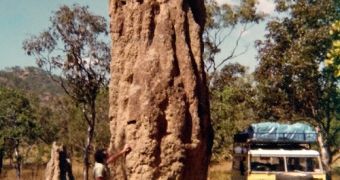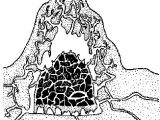Imagine you are in a remote area, lacking infrastructure, on a scorching heat, without equipment or too much manpower. Making geological prospects is extremely difficult in these conditions. And when a layer of sand, soil and gravel tens of meters thick covers all the underlying bedrock, the picture is complete.
Still, in these conditions, geologists discovered in the Kalahari desert (Botswana) the richest diamond deposit in the world. It all started when a geologist in the 1970s found a single fleck of a mineral named ilmenite on the ground's surface. Ilmenite is associated with a rock called kimberlite and kimberlite contains diamonds.
That telltale fleck revealed the place of now the biggest diamond mine: Jwaneng. But the minerals were located deep at 40 m (120 ft), so how did the ilmenite reach the surface?
It's all in the termites. Termites are known for their mounds, harboring the colony, made of clay combined with insects' saliva and feces, built on dry areas. The mounds can be up to 6 m (20 ft) tall above the earth, but underground they can be even bigger.
To keep the air wet inside the nest, for them and their fungi crops, the termites dig galleries to the table water or underground springs, even 75 m (225 ft) deep.
Moreover, inside the termite mound, there is constantly a humidity of 100 % and a temperature varying between 29?C (84? F) to 31?C (88? F), necessary for both fungi and termites. The galleries form a perfect installation of conditioning air. The orientation north-south of the mounds also helps in thermoregulation. The column of hot air rising in the above ground mounds helps drive air circulation currents inside the subterranean network.
If a mound is damaged, it is immediately fixed to protect the colony, and the mounds are constantly remodeled, a process that also requires water. The termites clamp bits of clay or wet rock in their jaws, then climb back home to build the mound, grain by damp grain. The mound goes higher, because everything they dig is brought up to surface, including the hardest particles. In doing this they bring up samples from that depth.
Thus, an analysis of the termite mounds can give a quick answer to the contents of deeper laying levels of soil and even rock.
Australian geologists say the termites are the ticket to new reserves of diamonds, gold and other buried treasures. In fact, ancient African civilizations used the termite mounds to locate gold deposits.
Some termite mounds can be so rich in gold that dissolving them and panning the slurry provides a significant side income for poorer residents of tropical regions. In a prospected area, termite mounds are isolated, dug up and analyzed for gold.
The mounds are everywhere in the terrain and sampling and analyzing is cheap, about US$ 20.00 per sample. Using this method, gold prospects have been found in Southern Africa and several countries in western Africa, like Mali and Niger.
The ancient and cheap method led to the discovery of the Vila Manica copper deposit in Mozambique in 1973.

 14 DAY TRIAL //
14 DAY TRIAL // 
